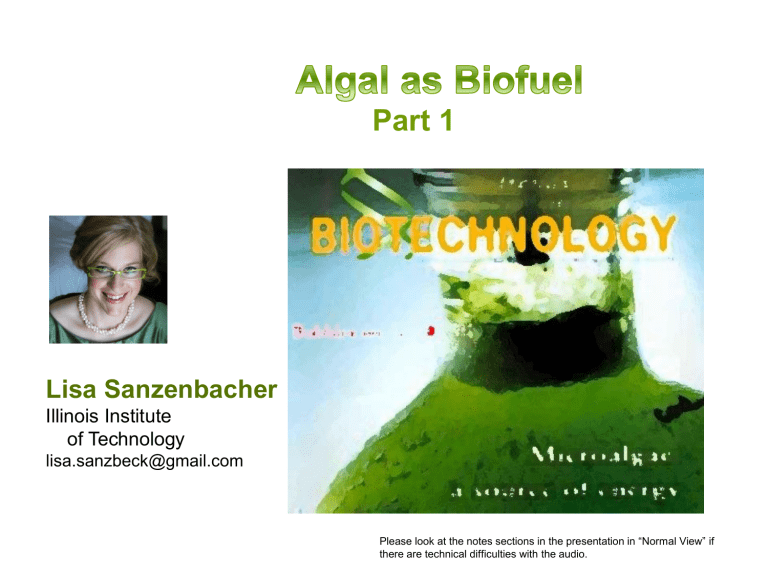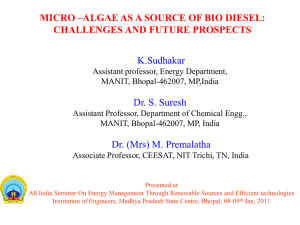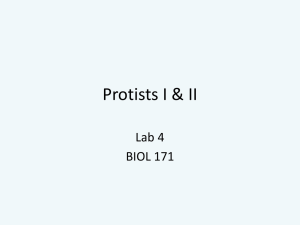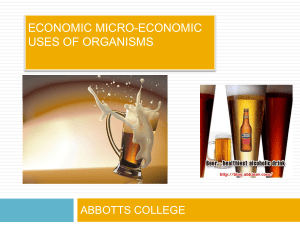Food for Thought: Algae as Fuel

Part 1
Lisa Sanzenbacher
Illinois Institute of Technology lisa.sanzbeck
@ gmail.com
Please look at the notes sections in the presentation in “Normal View” if there are technical difficulties with the audio.
Outline
•
Interest in Algae
•
Converting Sunlight to Chemical Energy
•
Resulting impacts of manufacturing algal fuel
•
Comparing the impacts to other fuel sources
•
Using Algae to Help Coal
•
Algae as a Transportation Fuel
•
Legal Considerations
•
Part 2…
Interest in Algae
For over 50 years, algae was known to be a renewable source of energy
Reliance on
Fossil Energy for
Transportation
Fuel
•
95% of the united State’s transportation fuel comes from petroleum
•
United States relies on foreign oil: imports 3 billion gallons per year
Fuel from algae first discovered in the 1950’s
First oil shock facilitated
Aquatic Species Program
Department of Energy funded ASP in 1970’s and 1980’s
Funding died in 1990’s because of cheap price of petroleum
Climate change and energy security Issues revitalized algal research
EPA notes:
Transportation sector
2 nd largest contributor to GHG emissions
Energy
Independence and Security
Act of 2007
•
Renewable Portfolio Standards mandate an increase in non-corn based fuels
•
Algae to provide “biomass based diesel” “other advanced fuels”
•
“21 billion gallons by 2022”
Research is booming
Harnessing the
Sun’s Energy
Moving away form petroleum allows us to use a renewable source of energy, but it comes with it’s price
what is algae?
•
Multi-cellular plant
•
Cholorphyll
•
Occurs naturally in lake and streams with high amounts phosphorus and nitrogen
•
2 nd Generation Renewable Biofuel characterized by
•
Higher solar energy yield
•
Year-round cultivation
•
Ability to utilize gray waters and non-arable lands
•
Produces biodegradable biofuels
converting sunlight into a fuel
•
Growth
•
Photobioreactor
•
Open ponds
•
Photosynthesis
•
10%solar energy conversion efficiency
•
Carbohydrate, Oxygen
Nutrient Restriction
Less nutrient less growth, more lipids
De-water
Extraction
Transesterification
Algal Impacts
•
Life Cycle Impact Assessment reveals high energy requirements for biodiesel production
•
Electricity for pumping, sparging, dewatering
•
Natural Gas for heating
Energy, Economic & Environmental
Comparison
Energy Output, Price & GHG
Contribution
Diesel Soybean Algae
Fuel Combustion Emissions
Diesel Soybean Algae
Net Energy
Ratio*
“strain to pump”
GHG #
Price per gallon
0.19
17
1.64
-71
$3.19
$4.20
* MJ consumed/MJ produced
# gCO2e/MJ
0.93
-75
$2.50-
$25 mpg
CO
PAH pm
SO
2
NO x
* B100 blend
1
1
1
1
1
1
0.93
0.57
0.20
0.45
0
1.13
0.93
0.57
0.20
0.45
0
1.13
Soybean
Diesel
Algae
0,5
Energy & Environmental
Comparison
1
Environmental Impacts of Making Fuels
0
Algae
Requirements:
Sunlight
CO2
Water
(some) land
Nutrients like
Nitrogen
&
Phosphorus
Using Algae to Help
Coal
One industry’s trash is another industry’s treasure
From Waste to Resource
CO
2
Water
Algal Requirements
Land
Nutrients
Sunlight
CO
2
Coal Plant Waste
Ash & Slag
Waste Water/ effluent
NOx
Sulfur
•
If algae promises to be the next source of transportation fuel
•
Requires a lot of clean CO2- more than what atmosphere can provide
•
40 billion gallons algae fuel requires CO2 from 32% of all US coal power plant
IGCC as Source of CO
2
GE's IGCC with CO
2 capture process
© The General Electric Company. This material may not be copied or distributed in whole or in part, without the prior written permission of the copyright owner
•
Integrated Gas Combined Cycle gasifies coal to H
2
(“syngas”) and CO
•
Removes impurities like sulfur
•
Ability to use Illinois
•
H
2 bituminous coal and CO fires first gas turbine to produce electricity
•
Exhaust heat fires second steam turbine generator to produce electricity again
•
CO combusted with controlled
O
2 to produce CO
2
•
CO2 can be sequestered
IGCC as Source of Additional
Algal Inputs
Eni Project, Monterotondo, Italy
•
Future Gen’s IGCC Plant
•
1 – 2.5 MMT CO2
•
50,000 – 120,000 gallons biodiesel annual
•
Sequestered carbon directed to nearby algae plant
•
Convert NOx into ammonia, a fertilizer for algae
•
React CO with H
2 methanol to create
•
CO + 2H
2
CH
3
-OH
•
Methanol is a necessary and expensive reactant to create biodiesel
Algae as a Source of
Biomass
•
Algae can make
•
30% oil
•
70% dry biomass
•
Midwest Generation Biomass
Cofiring Test with 10% biomass blending
•
Lower fuel costs
•
3.5 – 5% SO2 reduction
•
No reduction in pm, NOx
Siting Algae Plant adjacent to
IGCC Plant
•
Siting Algae plant near existing IGCC plants
•
Legal Benefits
•
No extensive energy to pump thousands of feet underground
•
Potential SDWA issues averted, possibly CERCLA?
•
Economic benefits
•
$400,000 per MW to sequester Carbon
•
Typical 500MW plant
$200 million
Global Energy Wabash River LP ASU and Steam Injection
•
Algae + IGCC still not a “cure all”
•
Mining coal causes Acid Mine
Drainage
Algae as a
Transportation Fuel
Biodiesel
+
Hybrid
Vehicles
150%
113%
Increased Fuel Effic nci es of Varous Fuels
Full Hybrid, Biodiesel (60 mpg) Full Hybrid, Gasoline (50 mpg)
Petro Diesel (30 mpg) B100 Biodiesel (27 mpg)
122%
89%
100%
70%
25%
13% over gasoline
18%
11% over biodiesel over petro‐diesel over gasoline hybrid
e
•
Algae + Hybrid
Vehicles still not a
“cure all”
•
NOx emissions contribute to upper respiratory tract infections
First Car to run on algae biodiesel
2005
Algaeus
2009
Peugeot 3008 HYbrid 4
Spring 2011
Legal Implications
Considerations for Algae Biodiesel
Regulatory Questions
Helping the Electricity Generation Sector
CAA
NSR?
SDWA
CWA
CERCLA
Helping the Transportation Sector
CAFE standards
EPA + NHTSA joint ruling
34.1 mpg
§202 CAA
RPS
Conclusions
Algae is a good start…
“algal biodiesel will almost completely replace conventional biodiesel”
Conclusions
But algae is not the answer
But…
“analytical results show that
algal biodiesel will not be the major energy source in 2040”











